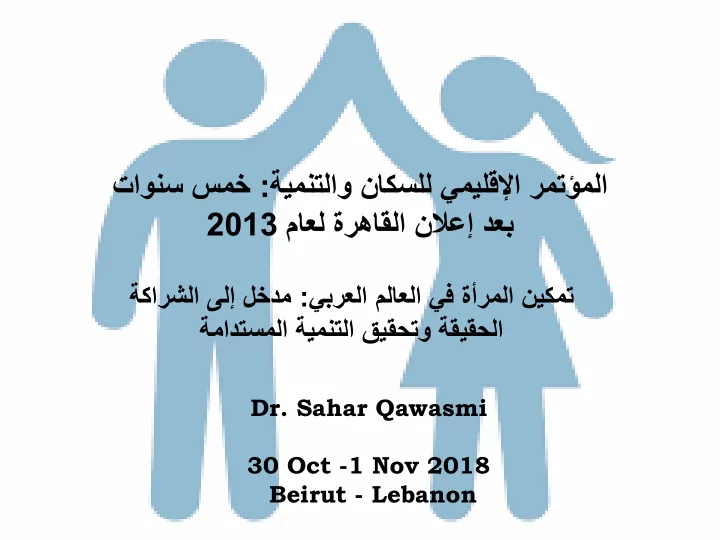

ةيمنتلاو ناكسلل يميلقلئا رمتؤملا : نس سمخ تاو ماعل ةرهاقلا نلبعإ دعب 2013 يبرعلا ملاعلا يف ةأرملا نيكمت : كارشلا ىلإ لخدم ة ةمادتسملا ةيمنتلا قيقحتو ةقيقحلا Dr. Sahar Qawasmi 30 Oct -1 Nov 2018 Beirut - Lebanon
Map indicating the human sex ratio by country
Median age by country. A youth bulge is evident for Africa, and to a lesser extent for West Asia, South Asia, Southeast Asia and Central America.
The demographic transition and the demographic dividend
Dependency ratio in the Arab region and subregions, 1980-2050 ( medium variant) Reference: Demographic profile of the Arab region achieve demographic gains Economic and Social Commission for Western Asia (ESCWA) Beirut, 2016
The demographic window of opportunity in Arab countries Arab countries are at different phases of the demographic transition and consequently have different time spans for the demographic window of opportunity. Most of them started to witness declines in the dependency ratio between the mid- 1970s and the early 1980s, with the share of the working-age population (persons aged 15-64 years) increasing around the same period. The four Arab subregions5 generally all show decreasing dependency ratios and increasing working-age population proportions between 1980 and 2040
Mashreq: support ratio and its annual Maghreb: support ratio and its annual growth rate, 1980-2050 growth rate, 1980-2050 Arab LDCs: support ratio and its annual growth rate, 1980-2050
The Arab region has the lowest participation of women in political life globally, and is ranked the lowest in political participation on the gender gap index. At only 15.2%, the region is far behind the global average of 22.1% of women represented in parliament. Source: http://arabstates.unwomen.org
According to World Bank data, the representation of Arab women in the labor market did not exceed 27 per cent. Source: European Journal of Business and Management
To build future economies that are both dynamic and inclusive, we must ensure that everyone has equal opportunity. When women and girls are not integrated — as both beneficiary and shaper — the global community loses out on skills, ideas and perspectives that are critical for addressing global challenges and harnessing new opportunities. Founder and Executive Chairman, World Economic Forum
Global performance, 2017
Performance by Region and Country The Global Gender Gap Index reveals that all countries can do more to close their gender gap. Across the Index, there are only seven countries that have closed 80% of the gap or more. In addition, there are 61 countries that have closed between 70% and 80% of their gender gap. A further 67 countries have closed between 60% and 70%, while nine countries have closed between 50% and 60%. In 2017, no country had closed less than 50% of their overall gender gap. However, there is wide variety in progress on closing the gender gap in every world region, with both success stories and underperforming countries in each. displays this year ’ s rankings by regional classification, organized by rank within each regional group.
At a global level, in 2017, four regions have a remaining gender gap of less than 30% — and two regions are crossing this threshold for the first time this year. Western Europe records a remaining gender gap of 25%, placing it ahead of North America, with a gap of 28%, Eastern Europe and Central Asia, with a gap of 29%, and Latin America and the Caribbean, with a gap of 29.8%. The East Asia and the Pacific region ranks ahead of Sub- Saharan Africa, with a remaining gender gap of 31.7% and 32.4%, respectively, and South Asia, with a gap of 34%. For the first time, the Middle East and North Africa region crosses the threshold of having a remaining gender gap of slightly less than 40%.
Distance from gender parity 2017, by region
It remains imperative for Arab countries in general to adapt and enforce fiscal and social policies and to provide adequate labor and social protection laws that support working Arab women and mothers in particular, including child support or maternity leave entitlements, especially in the private sector. In addition, given that women across the region play a key role in nationalization the workforce. Source: European Journal of Business and Management
Thank you
Recommend
More recommend